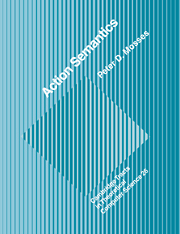Book contents
- Frontmatter
- Contents
- List of Boxes
- Preface
- Part I Introduction
- Part II Action Notation
- Chapter 4 Basic
- Chapter 5 Data
- Chapter 6 Functional
- Chapter 7 Declarative
- Chapter 8 Imperative
- Chapter 9 Reflective
- Chapter 10 Communicative
- Part III Semantic Descriptions
- Part IV Conclusion
- Appendices
- Bibliography
- Symbol Index
- Concept Index
Chapter 4 - Basic
Published online by Cambridge University Press: 19 January 2010
- Frontmatter
- Contents
- List of Boxes
- Preface
- Part I Introduction
- Part II Action Notation
- Chapter 4 Basic
- Chapter 5 Data
- Chapter 6 Functional
- Chapter 7 Declarative
- Chapter 8 Imperative
- Chapter 9 Reflective
- Chapter 10 Communicative
- Part III Semantic Descriptions
- Part IV Conclusion
- Appendices
- Bibliography
- Symbol Index
- Concept Index
Summary
Actions are semantic entities, used to represent behaviour.
Action notation includes a basic action notation for specifying control flow.
Basic actions are not explicitly concerned with any particular kind of information.
Chapter 11 illustrates the use of basic action notation in the semantic description of statements.
Actions are semantic entities that represent potential information-processing behaviour, i.e., the semantics of programs and of their component phrases, such as statements. Each performance of an action corresponds to a possible behaviour. In this chapter, we restrict our attention to the actions provided by basic action notation. These basic actions are closely related to fundamental concepts of control flow. In subsequent chapters, we enhance basic actions to process various kinds of information, and introduce further actions.
Before we look at our formal notation for actions, let us consider the concepts of control flow that underlie the intended interpretation of the notation. An action performance consists of some atomic steps, made by one or more agents. For now we only consider single-agent performances, and we assume that in any particular performance, steps occur in a definite order, rather than concurrently. This ensures that the current information available when performing a step is well-defined, and that conflicting changes to the current information cannot arise. Chapter 10 explains multi-agent performances, where a dynamically-changing distributed system of agents proceeds to perform separate actions with ‘true’ concurrency, with asynchronous sending of messages between agents.
- Type
- Chapter
- Information
- Action Semantics , pp. 59 - 66Publisher: Cambridge University PressPrint publication year: 1992

